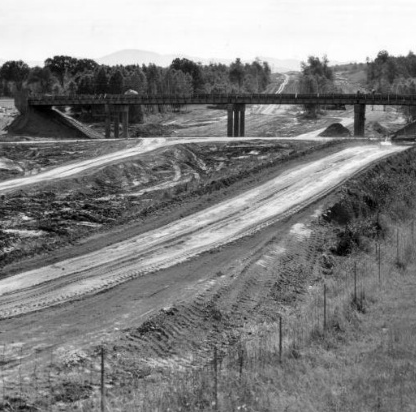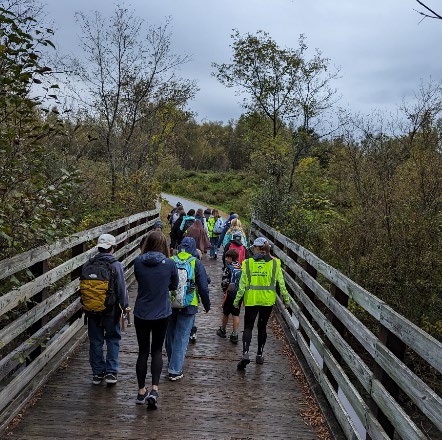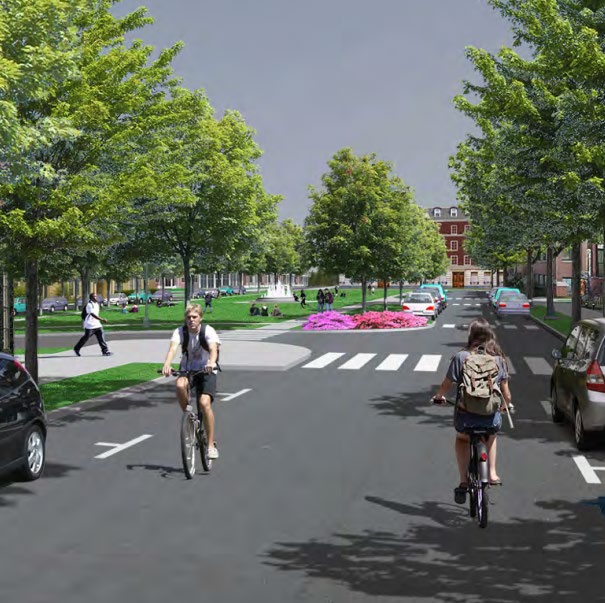Introduction
Mobility in Williston and to points beyond is critical to all who live, work, shop, and recreate here. Public and private infrastructure that supports the mobility of people and goods has significant and wide-ranging impacts on the Town and its people. Transportation infrastructure is probably the most costly and complicated type of asset for the town to construct, upgrade, and connect. At the same time, the way roads, bike paths, sidewalks, and transit systems are placed in our Town shapes our land use planning and the development pressures it attempts to address. Conversely, how we develop our land influences the opportunity to provide multi-modal choices to residents and visitors.
Given the great expense, complexity, and time related to making changes to our transportation infrastructure, and the near- permanence of those decisions once they have been implemented, we must make careful decisions about how to proceed. In response to extensive feedback from the public, this chapter proposes a significant focus on expanding and enhancing mobility in Williston for modes of transportation that do not require the use of an individually owned vehicle. Think walking, bicycling, taking the bus, and using ride-share or taxi services. While this chapter acknowledges that individuals choosing to drive alone will likely continue to make up most of the transportation in Town, it also recognizes that the choice to do so has been heavily shaped by a lack of other transportation options.
Safe space to walk and bike does not exist along many of Williston's roads. Bike paths and sidewalks sometimes end abruptly, do not connect to one another, or are interrupted by unsignalized crossings of busy roads. Bus service is limited and infrequent and only covers a small geographic area in Town. A complete and well-rounded transportation strategy will enable the town to facilitate the movement of people and goods, protect public safety, promote healthy lifestyles, and foster community building through the town.
This chapter lays out a set of goals, strategies, and actions intended to expand transportation options to all in Williston.
Recent Transportation History in Williston
While some of the roads in Williston do follow ancient pathways that date before the use of the passenger car, much of Williston's landscape has been shaped by a single major event- the construction of Interstate 89 and Exit 12, which made it convenient for shoppers from around the county and the state to come to Williston, and for Willistonians to live in the Town while commuting to work elsewhere. The development of Taft Corners as a suburban shopping center followed, with the first proposals for malls and shopping centers in the area arriving within a decade of the completion of the highway.
Almost as soon as Exit 12 was open to travel, Williston began to prepare for another major highway in Town, the Circumferential Highway, or "Circ," which would have connected Interstate 89 to Route 2 between Taft Corners and the Village, Mountain View Road, and Route 289 in Essex- and eventually all the way to Burlington via a "ring road." The 2011 Williston Comprehensive Plan had been almost entirely drafted and approved when then-governor Peter Shumlin held a press conference alongside Interstate 89 to announce that, after 40 years, tens of millions of dollars in planning, and several expensive lawsuits, the Circumferential Highway would not be built. Williston pivoted over the next few years, participating in a "Circ Alternatives" process that identified projects that could relieve congestion in Town in other ways, by making improvements to existing roads and intersections and by providing infrastructure for walkers and cyclists so alternatives to driving would be more available.
Circumferential Highway Alternatives projects for Williston include:
- I-89 Exit 12 Interchange Stage I-IV Improvements
- Stage 1: New Shared Use Path under Interstate & New VT2A Lane from Marshall Ave to I-89 NB Ramp (Completed in 2022)
- Stage 2: New Grid Streets and At Grade Intersection on VT2A between I-89 & Marshall Ave
- Stage 3: Diverging Diamond Interchange Improvements
- Stage 4: VT 2A Boulevard Upgrade from Grid St Intersection to Taft Corners
- Industrial Ave/Mountain View Rd/VT 2A - Intersection Improvements; New VT 2A Lane to James Brown Dr (In Progress as of 2025)
- New US 2 Taft Corners to Williston Village Shared Use Pathway and Village Sidewalk2Scoping study was completed in 2014 and was updated in 2025.
Short/Mid/Long Term Implementation Package of Phase III CIRC Alternative Projects. Chittenden County Regional Planning Commission. Accessed 4/7/2025 at https://www.ccrpcvt.org/wp-content/uploads/2016/01/20131121_PhaseIII_Project_List_Final.pdf.
A Network Implementation Plan was developed that identified specific transportation improvements, by mode, time frame, estimated cost, and lead agency for pursuing those improvements. For more details on this study, read the WENTS Final Report.4R.S.G. Transportation, Inc. prepared for Chittenden County Regional Planning Commission. 2014. Williston Essex Network Transportation Study (WENTS) – Final Report. Accessed 4/8/2025 at https://www.ccrpcvt.org/wp-content/uploads/2016/01/WENTS-Final-Report-March2014.pdf.
Action Areas
Taft Corners Grid Streets and Class I Town Highway Reclassification
In 2022, Williston adopted the Taft Corners Form Based Code, which envisions and codifies a vibrant mixed-use, urban village in the area surrounding intersection of 2 and 2A. This future for Taft Corners relies on the construction of grid streets to achieve a safe, walkable, livable, area that supports a mix of small businesses, housing, and green space as well as alleviating congestion and collision concerns on the main arteries.
The town is committed to building "Complete Streets" whenever possible. Complete Streets are those that include design features for addressing the needs of all modes of transportation not just vehicles. New transportation facilities should incorporate complete street design principles to the maximum extent possible, and improvements to existing roadways should incorporate facilities for non-motorized transportation users whenever feasible. To that end, the Taft Corners Form Based Code district incorporates street specifications that align with Complete Streets principles.
However, the goals of the town in building these grid streets including the incorporation of Complete Streets design principles, are not compatible with the two highways bisecting it. As early as 1991, Vermont AOT warned that they would not maintain ownership of a road with the number of intersections planned along Route 2A.
Williston is not unique in this respect. The state recognizes that conventional highways running through downtowns can be at odds with the needs of the individual towns that they run through and offers the Class 1 Town Highway reclassification process, wherein the town takes ownership for a segment of road, as a solution.
"Reclassification can have benefits for both the municipality and VTrans. It provides more flexibility to the municipality for streetscape design, traffic calming measures, placement of crosswalks, on-street parking, coordination of maintenance activities and the municipality receives annual compensation via Town Highway Aid. While at the same time the municipality retains eligibility for most state and federal grant programs. VTrans is relieved of maintaining a section of road that may require customized equipment or practices that are beyond the resources of VTrans maintenance staff."5Dubois and King, Inc., 2016. Class I Town Highways: Costs and Issues for Vermont Communities Considering Reclassification of State Highways. White Paper prepared for Vermont Agency of Transportation Policy, Planning and Research Bureau. Accessed 4/8/2025 at https://vtrans.vermont.gov/sites/aot/files/planning/documents/planning/Class%20I%20Town%20Highways%20White%20Paper.pdf.
Town Path and Sidewalk Network
A majority of the responses to Williston's public engagement process in Fall 2023 were about bike lanes, sidewalks, and bus routes. Some participants noted that a car is essentially required, and some of those said that Williston should not invest in this area to attempt to change that. A few participants commented about micro-transit.
- 40% of respondents stated that they think Williston's bike and pedestrian facilities are a strength of the town. Visiting the walking path behind Allen Brook School on any given day, you will see numerous users out for a walk, jog, or rollerblade.
- 89% of people typically drive alone when getting around Williston. While vehicle transportation has taken and will continue to take the largest share of our infrastructure budget, there is steady and vocal support for other options.
- Nearly 50% of respondents noted that improving bike and pedestrian facilities is a top town priority to addressing transportation challenges. Not only do people feel that the town needs more connected bike lanes and walking paths, but the town also needs to address bike and pedestrian safety through slower traffic speeds, better marked crosswalks, and street lighting.
- 55% of 254 respondents think that bike lanes and paths are the best way to encourage forms of transportation besides single occupancy vehicles.
- 66% of people think that Williston should fund and support the building of new paths and sidewalks, even if it increases taxes.
• Most of the areas that people feel unsafe walking and biking are along major roads6Town of Williston, Vermont, 2024. Town Plan Engagement Insights Report. https://www.town.williston.vt.us/vertical/sites/%7BF506B13C-605B-4878-8062-87E5927E49F0%7D/uploads/Williston_2050_Engagement_Insights_Report_Final_April_2024.pdf. Accessed April 29, 2024.
Volker, J. M. B., & Handy, S. (2021). Economic impacts on local businesses of investments in bicycle and pedestrian infrastructure: a review of the evidence. Transport Reviews, 41(4), 401–431. Accessed 4/8/2025 at https://doi.org/10.1080/01441647.2021.1912849.
Vermont Statutes. 24 V.S.A. § 4421. Official map. Accessed 4/8/2025 at https://legislature.vermont.gov/statutes/section/24/117/04421.

Figure 1: Summary of responses to online survey question about funding new paths and sidewalks.
Surrounding communities such as South Burlington have utilized a Penny for Paths program to ensure that these projects get consistent funding, both to increase pedestrian safety and close gaps in existing networks. A typical mechanism may be a dedicated 1 cent on the tax rate, such that a $300,000 property would pay $30 into this fund.
Public Transit
Williston currently has limited, fixed-route bus service provided by the Green Mountain Transit (GMT) and on-demand special transportation services provided by the Special Services Transportation Agency (SSTA). Map 8 – Existing Transportation Network shows the present bus routes. The #1 Williston/Burlington route runs every 20 minutes from 6:00 am to 11:10 pm Monday-Friday and on Saturday every 30 minutes from 7:40 am to 7:40 pm with less frequent service in the early morning and late evening hours. Sunday service runs about every 45 minutes from 8:40 am to 7:10 pm. The #10 Williston/Essex route runs Monday-Friday, 7:00 am to 6:15 pm with trips spaced 75 minutes apart.9Green Mountain Transit schedules, accessed 4/8/2025 at https://ridegmt.com/gmt-schedules/.
Green Mountain Transit Performance Dashboard. Accessed 4/8/2025 at https://ridegmt.com/performance-dashboard/.
Green Mountain Transit. Town of Williston 2024 Annual Report. Accessed 4/8/2025 at https://www.town.williston.vt.us/vertical/sites/%7BF506B13C-605B-4878-8062-87E5927E49F0%7D/uploads/2024_Annual_Town_Report.pdf.
Via Mobility, LLC., 2023. Williston Microtransit Study Final Report. Accessed 4/8/2025 at https://www.town.williston.vt.us/vertical/sites/%7BF506B13C-605B-4878-8062-87E5927E49F0%7D/uploads/Williston_Microtransit_Study_Final_Report_-_v2.pdf.



